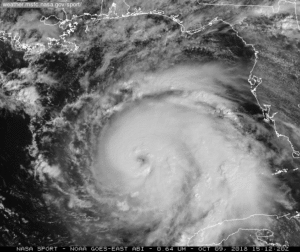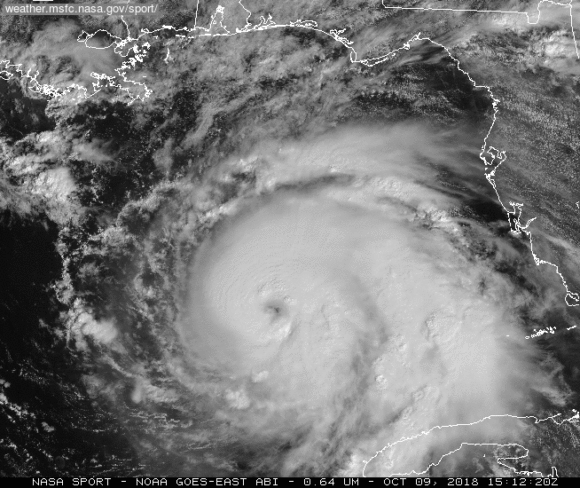Hurricane Michael, with winds strengthening to 145 miles an hour, is poised to be the strongest storm to hit the continental U.S. since 2004, with a life-threatening surge and the potential to cause $16 billion in damage.

Michael is about 90 miles (145 kilometers) southwest of Panama City, moving north at 13 miles per hour, according to the latest National Hurricane Center update. The swift-moving monster is racing to become the most intense storm ever to hit Florida’s panhandle region, with landfall set for Wednesday.
The storm has already cut Gulf of Mexico oil production by 40 percent and natural gas output by 28 percent. Warnings and watches have been issued for the Atlantic coast as far north as the Carolinas, regional ports are closed and more than 230 flights have been canceled. Duke Energy Corp. said it expects as many as 200,000 power outages.
“A storm like this could be a once-in-a-lifetime event,” said Brett Rathbun, a meteorologist with AccuWeather Inc. in State College, Pennsylvania. “Winds of this intensity can really knock down any tree or structure in its path.”
As a Category 4 storm, Michael would be the most intense to make landfall on the panhandle in U.S. records back to 1851, with the last major hurricane, Dennis, arriving as a Category 3 in 2005. The storm is churning 28-foot waves in the Gulf, and could bring a 14-foot surge and 4 to 8 inches of rain, with some isolated areas getting as much as 12 inches.
While Hurricane Florence‘s winds peaked at 137 miles per hour off the U.S. coast, they dropped in intensity prior to the storm’s September landfall in the Carolinas, and it’s known more for its rains than the strength of its winds. Florence caused devastating floods, killing at least 39 and causing about $45 billion in estimated damages.
Michael “will be a different monster than Florence,” Accuweather’s Rathbun said. Rather than lingering in one region as Florence did, inundating the Carolinas with rain, Michael is expected to race north to Georgia by Thursday, and reach the coast of Massachusetts by the weekend, he said.
However, the storm is expected to weaken after landfall as it moves across the southeastern U.S. before reemerging over the Atlantic, the hurricane center said in its advisory.
Damages from the storm could reach $16 billion, depending on its intensity after landfall and how quickly it moves through the region, according to Chuck Watson, of Enki Research in Savannah, Georgia, with Panama City taking the hardest hit.
“Michael is definitely shaping up to be a classic hurricane,” Watson said by email. “So the estimates are a bit more stable since you don’t have the stall and wander problem” that made Hurricane Florence hard to calculate.
Agriculture markets, meanwhile, were shrugging off the storm. Prices for cotton, soybean and corn crops fell on Tuesday, as did orange juice futures.
“Hurricanes are nearly always a ‘buy the rumor, sell the fact’ scenarios,” Louis Rose, the director of research and analysis a Rose Commodity Group, in Memphis, Tennessee, said by email.
While the panhandle is more sparsely populated than many other areas of Florida, it includes the capital city of Tallahassee, Pensacola and Panama City. The Atlantic has produced 14 named storms this year. They include Florence and Tropical Storm Gordon, which made landfall on the Alabama-Mississippi border last month.
Here’s the latest on the storm’s effects: The Coast Guard Tuesday closed ports at Gulfport and Pascagoula in Mississippi, Mobile in Alabama, and Panama City and Pensacola in Florida, and restricted vessel traffic on the Intracoastal Waterway. Total insured losses for Hurricane Michael should be manageable and have minimal impact on property reinsurance pricing, Keefe, Bruyette & Woods Inc. analyst Meyer Shields wrote in a note. Click here for Tuesday evening’s storm wrap showing impacts on oil and gas production, platforms and ports.
Was this article valuable?
Here are more articles you may enjoy.


 U.S. Severe Storms Continue to Drive Global Natural Disaster Losses: Gallagher Re
U.S. Severe Storms Continue to Drive Global Natural Disaster Losses: Gallagher Re  With American Mobile Cancellations, Florida Mobile Home Market Has ‘Fallen Apart’
With American Mobile Cancellations, Florida Mobile Home Market Has ‘Fallen Apart’  Insurers Face Business Interruption Claims After Global Tech Outage
Insurers Face Business Interruption Claims After Global Tech Outage  Northern California Fire Becomes State’s Biggest in a Day, Evacuations Ordered
Northern California Fire Becomes State’s Biggest in a Day, Evacuations Ordered 